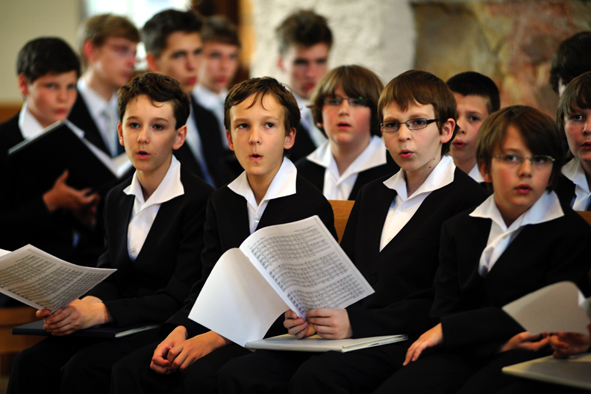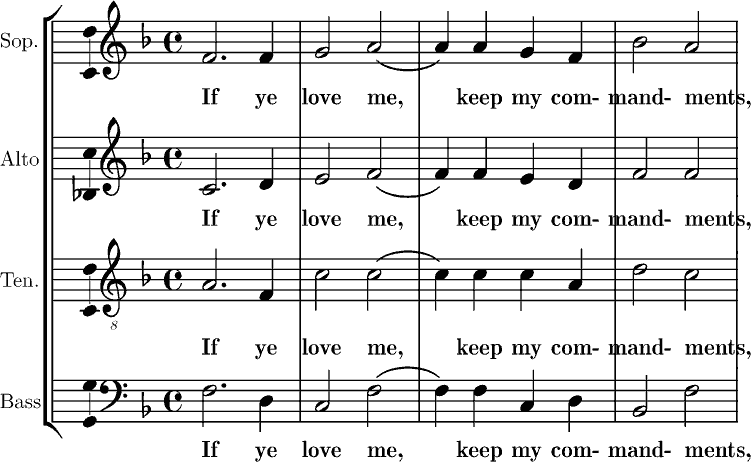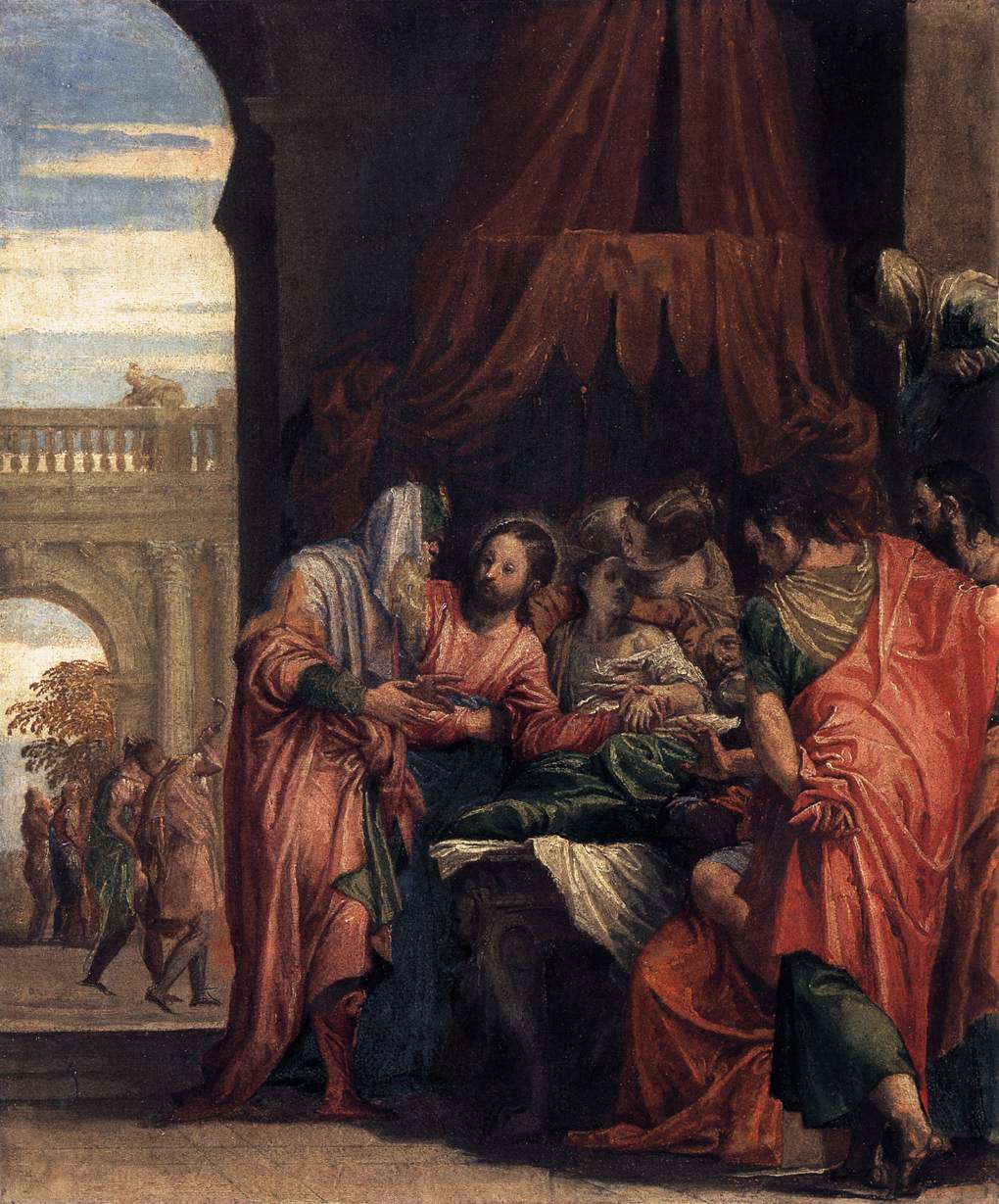|
Die Versuchung Jesu
' (The temptation of Jesus) is a composition for a mixed choir a cappella by Gustav Gunsenheimer, written in 1968. It is an (Gospel motet), based on the gospel in German of the temptation of Christ, written for one of the Sundays of Lent. The text is the biblical passage from the Gospel of Matthew (), followed by the first stanza from the hymn "" written by Georg Weissel, in a setting of the original melody by Johann Stobäus. The duration is given as 4 minutes. It was published by Carus-Verlag in 1968. A characteristic feature of the composition is that the part of the devil is rendered spoken, at times in canon. Series of motets Gunsenheimer composed a sequence of five motets for Sundays in Lent: # ', on the story of Jesus and two disciples (1966) # ' (1968) # ', on the raising of Jairus' daughter (1969) # ', on healing the blind near Jericho (1970) # ', on Jesus and the Canaanite woman (1971) He added a motet for a Sunday after Easter: ', on the story of the doubting Tho ... [...More Info...] [...Related Items...] OR: [Wikipedia] [Google] [Baidu] |
Evangelienmotette
''Evangelienmotetten'' or Gospel motets (sometimes called ''Spruchmotetten'', "Bible-text motets") were settings to music of verses from the New Testament. They were selected as an essence or ''Kernspruch'' ("text-kernel") of the verses in question, with the intention of highlighting dramatically or summarising in a terse fashion a significant thought from the Gospels. There is a long tradition in Germany, dating back to the medieval era, of highlighting the importance of gospel readings through polyphonic musical settings of gospel texts. They became an increasingly popular genre from the 16th century onwards and were intended for use in Lutheran church services. They could thus be written in either Latin or German. The latter came to predominate by the end of the 16th century due to the emphasis placed by the Reformation on the need to make the Bible accessible to all people through the use of the vernacular language. During the late 16th and early 17th centuries a number of comp ... [...More Info...] [...Related Items...] OR: [Wikipedia] [Google] [Baidu] |
Canon (music)
In music, a canon is a contrapuntal ( counterpoint-based) compositional technique that employs a melody with one or more imitations of the melody played after a given duration (e.g., quarter rest, one measure, etc.). The initial melody is called the leader (or ''dux''), while the imitative melody, which is played in a different voice, is called the follower (or ''comes''). The follower must imitate the leader, either as an exact replication of its rhythms and intervals or some transformation thereof. Repeating canons in which all voices are musically identical are called rounds—" Row, Row, Row Your Boat" and " Frère Jacques" are popular examples. An accompanied canon is a canon accompanied by one or more additional independent parts that do not imitate the melody. History Medieval and Renaissance During the Middle Ages, Renaissance, and Baroque—that is, through the early 18th century—any kind of imitative musical counterpoints were called fugues, with the strict ... [...More Info...] [...Related Items...] OR: [Wikipedia] [Google] [Baidu] |
Motets
In Western classical music, a motet is mainly a vocal musical composition, of highly diverse form and style, from high medieval music to the present. The motet was one of the pre-eminent polyphonic forms of Renaissance music. According to Margaret Bent, "a piece of music in several parts with words" is as precise a definition of the motet as will serve from the 13th to the late 16th century and beyond.Margaret Bent,The Late-Medieval Motet in ''Companion to Medieval & Renaissance Music'', edited by Tess Knighton and David Fallows, 114–19 (Berkeley, California: University of California Press, 1992): 114. . The late 13th-century theorist Johannes de Grocheo believed that the motet was "not to be celebrated in the presence of common people, because they do not notice its subtlety, nor are they delighted in hearing it, but in the presence of the educated and of those who are seeking out subtleties in the arts". Etymology In the early 20th century, it was generally believed the name ... [...More Info...] [...Related Items...] OR: [Wikipedia] [Google] [Baidu] |
Roderich Kreile
Roderich Kreile (born 1956) is a Lutheran church musician, choir director and university teacher. Since 1997, he has been the director of the Dresdner Kreuzchor at the Kreuzkirche, Dresden, as the 28th Kreuzkantor since the Reformation. Life and work Kreile studied church music and choral conducting in Munich. In 1981, he became a cantor at the Christ Church in Munich. From 1989 to 1996 he taught choral conducting at the Hochschule für Musik und Theater München. He was appointed Kirchenmusikdirektor (director of church music) in 1990. In 1994, he also prepared the choir Philharmonischer Chor München for concerts with the Münchner Philharmoniker. In 2010 he became a member of the Sächsische Akademie der Künste (Saxon Academy of Arts). He has been the vice chairman of the Neue Bachgesellschaft and an advisory board member of the International Heinrich Schütz Society. Since 1997, Kreile has been the 28th Kreuzkantor since the Reformation. Leading the Dresdner Kreuzch ... [...More Info...] [...Related Items...] OR: [Wikipedia] [Google] [Baidu] |
Dresdner Kreuzchor
The Dresdner Kreuzchor is the boys' choir of the Kreuzkirche in Dresden, Germany. It has a seven-century history and a world-wide reputation. Today, the choir has about 150 members between the ages of 9 and 19, from Dresden and the surrounding region. The boys attend the Kreuzschule in Dresden. They are also called "Kruzianer". Until summer 2022, the director of the choir is Roderich Kreile, who is the 28th "Kreuzkantor" (Cantor) since the Reformation. Next Kreuzkantor will be . The Cantor between 1971 and 1991 was Martin Flämig. Overview The repertoire of the choir includes compositions from the early Baroque (Heinrich Schütz, Johann Sebastian Bach), the early 19th century and modern work. Several recordings are available from Berlin Classics, Deutsche Grammophon and Capriccio. The choir often performs with the Sächsische Staatskapelle Dresden and the Dresden Philharmonic Orchestra. The choir sings Vespers almost every Saturday at 5 pm and on Sunday at 9:30 am in the Chur ... [...More Info...] [...Related Items...] OR: [Wikipedia] [Google] [Baidu] |
D Major
D major (or the key of D) is a major scale based on D, consisting of the pitches D, E, F, G, A, B, and C. Its key signature has two sharps. Its relative minor is B minor and its parallel minor is D minor. The D major scale is: : Characteristics According to Paolo Pietropaolo, D major is Miss Congeniality: it is persistent, sunny, and energetic. D major is well-suited to violin music because of the structure of the instrument, which is tuned G D A E. The open strings resonate sympathetically with the D string, producing a sound that is especially brilliant. This is also the case with all other orchestral strings. Thus, it is no coincidence that many classical composers throughout the centuries have chosen to write violin concertos in D major, including those by Mozart ( No. 2, 1775, No. 4, 1775); Ludwig van Beethoven (1806); Paganini ( No. 1, 1817); Brahms (1878); Tchaikovsky (1878); Prokofiev ( No. 1, 1917); Stravinsky (1931); and Korngold (1945). ... [...More Info...] [...Related Items...] OR: [Wikipedia] [Google] [Baidu] |
Recitative
Recitative (, also known by its Italian name "''recitativo''" ()) is a style of delivery (much used in operas, oratorios, and cantatas) in which a singer is allowed to adopt the rhythms and delivery of ordinary speech. Recitative does not repeat lines as formally composed songs do. It resembles sung ordinary speech more than a formal musical composition. Recitative can be distinguished on a continuum from more speech-like to more musically sung, with more sustained melodic lines. The mostly syllabic ''recitativo secco'' ("dry", accompanied only by continuo, typically cello and harpsichord) is at one end of the spectrum, through ''recitativo accompagnato'' (using orchestra), the more melismatic arioso, and finally the full-blown aria or ensemble, where the pulse is entirely governed by the music. Secco recitatives can be more improvisatory and free for the singer, since the accompaniment is so sparse; in contrast, when recitative is accompanied by orchestra, the singer must p ... [...More Info...] [...Related Items...] OR: [Wikipedia] [Google] [Baidu] |
Homophony
In music, homophony (;, Greek: ὁμόφωνος, ''homóphōnos'', from ὁμός, ''homós'', "same" and φωνή, ''phōnē'', "sound, tone") is a texture in which a primary part is supported by one or more additional strands that flesh out the harmony. One melody predominates while the other parts play either single notes or an elaborate accompaniment. This differentiation of roles contrasts with equal-voice polyphony (in which similar lines move with rhythmic and melodic independence to form an even texture) and monophony (in which all parts move in unison or octaves). Historically, homophony and its differentiated roles for parts emerged in tandem with tonality, which gave distinct harmonic functions to the soprano, bass and inner voices. A homophonic texture may be homorhythmic, which means that all parts have the same rhythm. Chorale texture is another variant of homophony. The most common type of homophony is melody-dominated homophony, in which one voice, often t ... [...More Info...] [...Related Items...] OR: [Wikipedia] [Google] [Baidu] |
F-sharp Minor
F-sharp minor is a minor scale based on F, consisting of the pitches F, G, A, B, C, D, and E. Its key signature has three sharps. Its relative major is A major and its parallel major is F-sharp major (or enharmonically G-flat major). The F-sharp natural minor scale is: : Changes needed for the melodic and harmonic versions of the scale are written in with accidentals as necessary. The F-sharp harmonic minor and melodic minor scales are: : : Music in F-sharp minor Very few symphonies are written in this key, Haydn's '' Farewell Symphony'' being one famous example. George Frederick Bristow and Dora Pejačević also wrote symphonies in this key. The few concerti written in this key are usually written for the composer himself to play, including Rachmaninoff's Piano Concerto No. 1, Scriabin's Piano Concerto, Wieniawski's Violin Concerto No. 1, Vieuxtemps's Violin Concerto No. 2, and Koussevitzky's Double Bass Concerto. In addition to the ''Farewel ... [...More Info...] [...Related Items...] OR: [Wikipedia] [Google] [Baidu] |
Doubting Thomas
A doubting Thomas is a skeptic who refuses to believe without direct personal experience — a reference to the Gospel of John's depiction of the Apostle Thomas, who, in John's account, refused to believe the resurrected Jesus had appeared to the ten other apostles until he could see and feel Jesus' crucifixion wounds. In art, the episode (formally called the Incredulity of Thomas) has been frequently depicted since at least the 15th century, with its depiction reflecting a range of theological interpretations. Gospel account The episode is related in chapter 20 of the Gospel of John, but not in the three synoptic Gospels. The text of the King James Version is as follows: Commentators have noted that John avoids saying whether Thomas actually did "thrust" his hand in. Before the Protestant Reformation the usual belief, reflected in artistic depictions, was that he had done so, which most Catholic writers continued to believe, while Protestant writers often thought that h ... [...More Info...] [...Related Items...] OR: [Wikipedia] [Google] [Baidu] |
Healing The Blind Near Jericho
Each of the three Synoptic Gospels tells of Jesus healing the blind near Jericho, as he passed through that town, shortly before his passion. The Gospel of Mark tells of the curing of a man named Bartimaeus, healed by Jesus as he is leaving Jericho. The Gospel of Matthew and the Gospel of Luke include different versions of this story. Narrative The Gospel of Mark () tells of the curing of a blind beggar named Bartimaeus (literally "Son of Timaeus"). He is one of the few recipients of healing whose names evangelists let us know. As Jesus is leaving Jericho with his followers, Bartimaeus calls out: 'Son of David, have mercy on me!' and persists even though the crowd tries to silence him. Jesus has them bring the man to him and asks him what he wants; he asks to be able to see. Jesus tells him that his faith has cured him; he immediately receives his sight and follows Jesus. Apart from telling a miracle story that shows the power of Jesus, the author of the Gospel uses this stor ... [...More Info...] [...Related Items...] OR: [Wikipedia] [Google] [Baidu] |
Raising Of Jairus' Daughter
The raising of Jairus' daughter is a reported miracle of Jesus that occurs in the synoptic Gospels, where it is interwoven with the account of the healing of a bleeding woman. The narratives can be found in Mark 5:21–43, Matthew 9:18–26 and Luke 8:40–56. Summary Scholars have long recognised the Lukan and Matthean accounts of the story derive from the Markan account and are a typical example of a Synoptic triple tradition. It has no equivalent in the Gospel of John. Although some have drawn comparisons with the Healing the royal official's son ( John 4) and Raising of Lazarus ( John 11) narratives, Zwiep (2015) stated that 'they are entirely different and unrelated stories, according to most biblical scholars to date.' Premise The differences between the three Gospel narratives are well known amongst scholars. The premise of the story in Mark and Luke is that a ruler (Mark: εἷς τῶν ἀρχισυναγώγων "one of the synagogue rulers"; Luke: ἄρχ ... [...More Info...] [...Related Items...] OR: [Wikipedia] [Google] [Baidu] |






